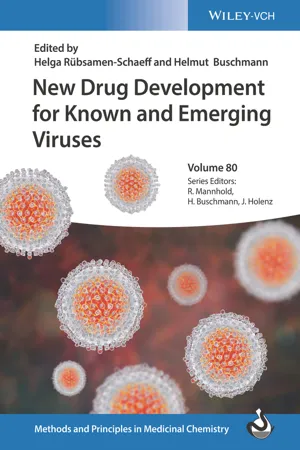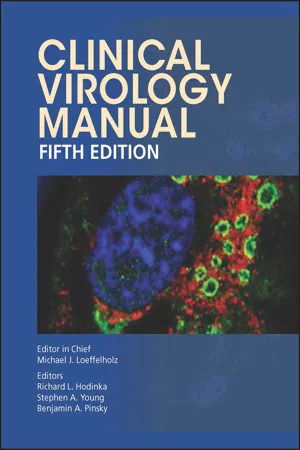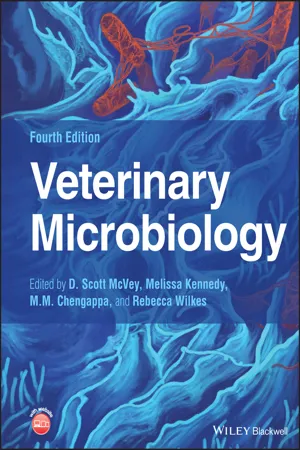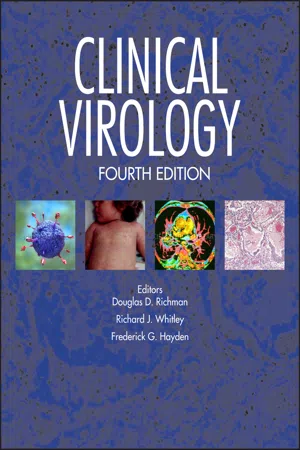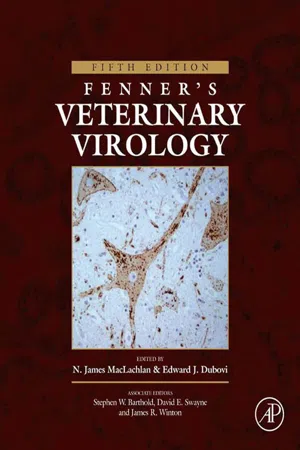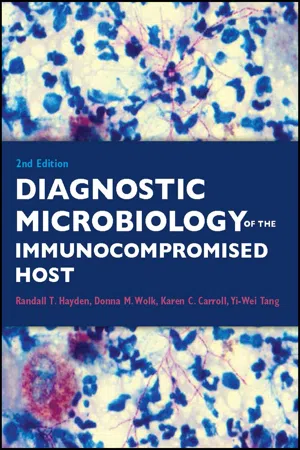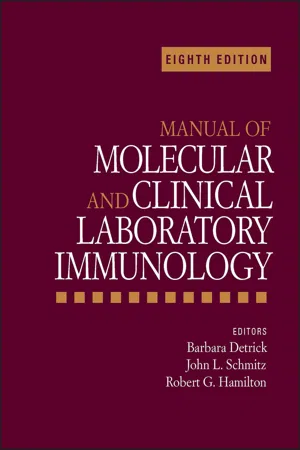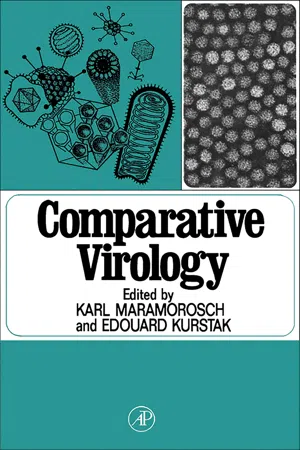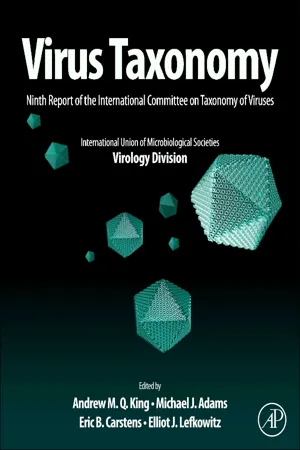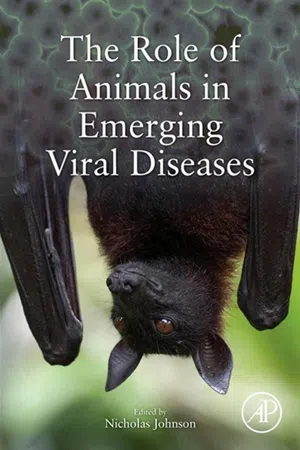Biological Sciences
Parvovirus
Parvovirus is a small, single-stranded DNA virus that can infect a wide range of animals, including humans. It is known for causing diseases such as fifth disease in humans and parvoviral enteritis in dogs. Parvovirus is highly contagious and can be transmitted through direct contact with infected individuals or their bodily fluids.
Written by Perlego with AI-assistance
11 Key excerpts on "Parvovirus"
- Helga Rübsamen-Schaeff, Helmut Buschmann, Raimund Mannhold, Jörg Holenz, Helga Rübsamen-Schaeff, Helmut Buschmann(Authors)
- 2021(Publication Date)
- Wiley-VCH(Publisher)
12 ssDNA-Viruses: Human Parvovirus InfectionSusanne ModrowInstitute of Medical Microbiology and Hygiene, University of Regensburg, Regensburg, Germany12.1 Introduction
Single-stranded DNA-viruses are classified into the families of Parvoviridae, Circoviridae, and Anelloviridae. All these viruses are characterized as small, non-enveloped particles with genomes of 1.7–2.1 kilo bases (1000 bases) (kb) (Circoviridae), 2.0–3.9 kb (Anelloviridae), and 4.0–6.0 kb (Parvoviridae) [1 –3 ]. With respect to anelloviruses, various species of Torque-teno-, Torque-teno-midi- and Torque-teno-mini-viruses (TTV, TTMDV, TTMV) have been identified to persist in vertebrates including humans, but diseases have been associated neither with acute infection nor with persistence [4 –6 ]. Circoviruses are well-known pathogens of livestock and animals: human-associated circoviral DNA-sequences could be amplified from various samples and excretions from patients as well as from healthy humans [7] . With respect to Parvoviruses, several species are well-known risk factors for fetal health both in livestock and pets, e.g. porcine Parvovirus, canine minute virus, and feline panleukopenia virus. Two parvoviral species, human Parvovirus B19 (B19V) and human bocavirus (HBoV), are recognized as human pathogens and will be discussed in this chapter.12.2 Classification
The family of Parvoviridae comprises viruses characterized by small (lat. parvus = small), non-enveloped particles with a diameter of 20–28 nm containing a linear single-stranded DNA (ssDNA) molecule of about 5000–6000 nucleotides. Parvovirus B19 (primate erythroParvovirus 1, B19V) and human bocavirus (primate bocaParvovirus HBoV 1, 2) occur within the subfamily Parvovirinae, genera Erythroparvo- and BocaParvovirus, respectively. During the past years, several other Parvoviruses have been isolated from humans, including Parvovirus 4 (PARV4), human bufavirus (BuV), cutavirus (CutaV), and tusavirus (TusaV) [8 , 9 ]. Until now, their clinical significance and association with human diseases remain unclear. Furthermore, most humans are infected with adeno-associated virus (AAV), members of the genus DependoParvovirus, without developing symptoms. Whereas AAV-replication is dependent on concurrent infection of the cells by adeno- or herpesviruses, all other human Parvoviruses are not dependent on helper-viruses and replicate autonomously. Parvovirus B19 displays a preference to infect erythroid precursor cells; the tropism of human bocavirus is targeted to cells of the respiratory and/or gastrointestinal tract [10 –12- eBook - ePub
- Richard L. Hodinka, Stephen A. Young, Benjamin A. Pinksy, Richard L. Hodinka, Stephen A. Young, Benjamin A. Pinksy(Authors)
- 2016(Publication Date)
- ASM Press(Publisher)
The name is derived from the Latin word “parvus,” meaning “small,” as befitted their appearance on electron microscopy. The Parvovirus genome consists of a single-stranded DNA (ssDNA) molecule of approximately 5,000 bases. As would be expected of such a small genome, Parvoviruses have a relatively simple replication strategy compared to viruses with larger more complex genomes. Unlike other more complex DNA viruses, Parvoviruses are unable to stimulate the cellular division needed for replication and therefore require actively dividing cells to infect. Exceptions to this requirement are the AAVs, which are incapable of independent replication and require the aid of a helper virus, typically an adenovirus, or less commonly a herpesvirus, to complete their replicative cycle (2). The replicative strategy of the autonomous Parvoviruses varies among the many viruses but generally follows a pattern of transcription of two non-structural (NS) proteins involved in control of replication from the left side of the genome and structural VP proteins from the right side of the genome (3). One unusual aspect of Parvovirus replication is the ability of some Parvoviruses, including human Parvovirus B19, to encapsidate both positive and negative strands of the genomic ssDNA. Another noteworthy feature of these viruses is that although their genomes are replicated by host cell polymerases, they appear to have relatively high mutation and recombination rates, a characteristic that has been attributed to the single-stranded configuration of their genomes (3). This mutability may play a role in the appearance of Parvoviruses with expanded host ranges. For example, canine Parvovirus type 2, the causative agent of a serious infection of dogs, is believed to have arisen in the 1970s as a result of the mutation of feline panleukopenia virus via an intermediate wild carnivore host (4) - eBook - ePub
- D. Scott McVey, Melissa Kennedy, M. M. Chengappa, Rebecca Wilkes, D. Scott McVey, Melissa Kennedy, M. M. Chengappa, Rebecca Wilkes(Authors)
- 2022(Publication Date)
- Wiley-Blackwell(Publisher)
47 ParvoviridaeRebecca P. WilkesThe family Parvoviridae is a large and diverse family of viruses and currently comprises three subfamilies: Parvovirinae, Hamaparvovirinae, and Densovirinae. The subfamily Parvovirinae contains viruses of veterinary importance and is the focus of this chapter. This subfamily has 10 genera: ProtoParvovirus, ErythroParvovirus, ArtiParvovirus, LoriParvovirus, DependoParvovirus, AmdoParvovirus, AveParvovirus, CopiParvovirus, TetraParvovirus, and BocaParvovirus, and at present contains 75 species. Parvoviruses have a broad range of impacts on their hosts, differing from severe clinical disease to subclinical or nonpathogenic infection. For example, Parvoviruses detected in rodents, pinnipeds, and primates most commonly cause subclinical infections, whereas Parvovirus infections in dogs and cats may be fatal. In general, clinical disease caused by Parvoviruses is more severe in fetuses, neonates, and young animals.The Parvoviruses are mainly species specific and named according to their host/reservoir species; however, some Parvovirus species have altered their host range to create pandemic viruses, such as occurred with canine Parvovirus (CPV ). With the advent of next‐generation sequencing, “new” Parvoviruses are regularly discovered. Despite epidemiological studies, any possible association with the clinical signs of most of these newly described viruses remains unclear. Considering that many Parvoviruses are clinically silent, the significance of newly identified Parvoviruses must be determined.The name Parvovirus is derived from the Latin term parvus, which means “small.” Parvoviruses are some of the smallest viruses known (18–26 nm). These viruses are nonenveloped, have icosahedral symmetry, and contain a linear single‐stranded DNA genome of approximately 4–6 kb. In both terminal sequences of the virus, a complex palindromic hairpin structure is located and required for DNA replication. The polarity of the genome strand is either negative sense only or a proportion of individually encapsidated negative and positive strands. The genomes of Parvovirinae viruses contain two major expression cassettes, with open reading frames (ORF s) on the left‐hand side coding for non‐structural (NS ) proteins, whereas those from the right‐hand side give rise to the structural proteins (VPs). The largest of the NS proteins, traditionally designated NS1, contains a highly conserved domain and is essential for virus replication. Based on its conservation, this gene sequence is used to define family taxonomy. The capsid is composed of VPs, which control binding to host cells and define the host range. Interestingly, Parvoviruses have high levels of genetic diversity and evolve at rates approaching those observed for RNA viruses. However, just a small number of mutations in the capsid protein gene that alter residues on the surface of the capsid can allow infection of a new host, which results in a new virus. These genetic differences in the capsid gene of ProtoParvovirus between strains also make sequencing of this gene useful for characterizing these Parvovirus strains in animals that can be infected by multiple Parvoviruses. The ability of some animal species to be infected by multiple Parvoviruses also allows for recombination between Parvovirus strains, which adds to increased genetic variation. Changes in Parvoviruses over time (as described for CPV, feline Parvovirus, and porcine Parvovirus [PPV - eBook - ePub
- Douglas D. Richman, Richard J. Whitley, Frederick G. Hayden, Douglas D. Richman, Richard J. Whitley, Frederick G. Hayden, Douglas D. Richman, Richard J. Whitley, Frederick G. Hayden(Authors)
- 2016(Publication Date)
- ASM Press(Publisher)
30 Human Parvoviruses MARIA SÖDERLUND-VENERMO, KEVIN E. BROWN, AND DEAN D. ERDMANParvoviruses have been isolated from a wide range of animals, including mammals, birds, insects, crustaceans, and reptiles. These viruses tend to be species-specific and can cause a variety of serious diseases in their host species (1 ). The first Parvoviruses isolated from humans were adeno-associated Parvoviruses, which have not yet been linked with disease. Until recently the only Parvovirus associated with human disease was human Parvovirus B19 (B19V), which was fortuitously identified in 1975 during an evaluation of tests for hepatitis B virus antigens (2 ). B19V has been associated with erythema infectiosum, transient aplastic crisis, chronic anemia in patients with impaired immune systems, hydrops fetalis, and purportedly a number of other conditions (3 ). Seven additional Parvoviruses have recently been detected in humans by molecular screening for new sequences, including human bocavirus (HBoV)1–4, tetraParvovirus (PARV4), bufavirus (BuV), and tusavirus (TuV) (4 –9 ). HBoV1 causes acute respiratory illness (10 ) and, as with HBoV2 and 3, possibly also encephalitis (11 ). The other recently discovered human Parvoviruses are yet to be associated with human disease.VIROLOGY
Classification and Genotypes
Parvoviruses are small, nonenveloped, single-stranded DNA viruses that infect a variety of animals, usually in a species-specific fashion. The family Parvoviridae is divided into two subfamilies: the Densovirinae , which infect arthropods, and the Parvovirinae , which infect vertebrates. The members of the Parvovirinae that infect humans will be the focus of this chapter. The subfamily Parvovirinae is divided into eight genera: ProtoParvovirus, ErythroParvovirus, DependoParvovirus, AmdoParvovirus, BocaParvovirus , AveParvovirus, CopiParvovirus, and TetraParvovirus (1 ). The Parvoviruses known to infect humans include B19V in the genus ErythroParvovirus , adenovirus-associated viruses (AAVs) in the genus DependoParvovirus , HBoV1–4 in the genus BocaParvovirus , PARV4 in the genus TetraParvovirus , and BuV and potentially TuV in the genus ProtoParvovirus (Fig. 1 - eBook - ePub
- N. James Maclachlan, Edward J Dubovi(Authors)
- 2010(Publication Date)
- Academic Press(Publisher)
Despite their complex taxonomic organization, the Parvoviruses are all related and likely derive from an ancient common ancestor. They share common biological properties, including their resistance to desiccation in the environment and their requirement for cells that are passing through mitotic S phase in order to replicate their DNA. The relative increased availability of mitotically active cells in specific tissues in early life confers an age-dependent susceptibility to several Parvovirus-induced diseases. Thus, certain Parvovirus infections are most severe in fetuses (after transplacental infection) and neonates. This requirement for mitotically active cells also is reflected in the tropism of some Parvoviruses for rapidly dividing hemopoietic precursors and lymphocytes, and progenitor cells of the intestinal mucosal lining.Properties of ParvovirusES
Classification
The family Parvoviridae comprises two subfamilies: the subfamily Parvovirinae , which contains viruses of vertebrates, and the subfamily Densovirinae , which contains viruses of insects and other invertebrates (that will not be discussed further). There are currently eight designated genera in the subfamily Parvovirinae . The taxonomic organization of Parvoviruses can be confusing, as these viruses are grouped into genera according to their molecular properties and not their host species of origin. In addition, recent changes in nomenclature make it difficult to identify historic names of virus species so, for clarity, the well established colloquial names of individual Parvoviruses causing specific animal diseases will be used throughout this chapter. Aleutian mink disease virus is included in the genus AmdoParvovirus (previously Amdovirus ), along with gray fox amdovirus. Some replication competent Parvoviruses of birds (eg, goose and duck Parvoviruses) are included in the genus DependoParvovirus along with adeno-associated viruses of mammals that are reliant on the presence of a helper virus for their efficient replication, whereas the intestinal Parvoviruses of chickens and turkeys are now included in the genus AveParvovirus . A variety of Parvoviruses from dogs (including canine minute virus, or canine Parvovirus 1 or canine bocavirus), marine mammals, primates, and ungulates are included in the genus BocaParvovirus (previously Bocavirus ). The genus CopiParvovirus includes at least two additional ungulate Parvoviruses. The genus ErythroParvovirus (previously Erythrovirus ) includes human Parvovirus B19 and related viruses of nonhuman primates and ungulates. The genus ProtoParvovirus (previously Parvovirus ) includes: feline panleukopenia virus and the closely related canine Parvovirus, mink enteritis virus, and raccoon Parvovirus; Parvoviruses of rodents and lagomorphs; and Parvoviruses of ungulates and primates. Newly recognized viruses related to the human Parvovirus-4 are now classified in the genus TetraParvovirus - eBook - ePub
- Randall T. Hayden, Karen C. Carroll, Yi-Wei Tang, Donna M. Wolk, Randall T. Hayden, Karen C. Carroll, Yi-Wei Tang, Donna M. Wolk, Randall T. Hayden, Karen C. Carroll, Yi-Wei Tang, Donna M. Wolk(Authors)
- 2016(Publication Date)
- ASM Press(Publisher)
15 ). There is no treatment.PARV4, first reported in an intravenous-drug user with hepatitis B virus, has since been found mostly in blood or tissues of persons with hepatitis C or human immunodeficiency virus (HIV) (16 , 17 ). Bufavirus, a highly divergent Parvovirus, was identified in feces of children with diarrhea in Burkina Faso and was subsequently found in feces of gastroenteritis patients in northern Europe (18 , 19 ). Since the impact of these viruses in the compromised host is not well understood (20 ), this chapter will focus on Parvovirus B19.Parvoviridae are named for their small size, parvum being Latin for small. The family, which includes both animal and insect pathogens, is divided into two sub-families based on infection of vertebrate or invertebrate cells. The vertebrate Parvovirinae subfamily consists of eight genera and five are known to include human pathogens: ProtoParvovirus (bufavirus), BocaParvovirus (human bocavirus), DependoParvovirus (adeno-associated virus), ErythroParvovirus (Parvovirus B19), and TetraParvovirus (PARV4). The new phylogeny is based on the protein sequence of the replication-initiator protein NS1 (21 ).Parvovirus B19, of the genus ErythroParvovirus , consists of a highly stable nonenveloped icosahedral virion, 22–24 nm in diameter, with a single-stranded 5.6 kilobase DNA genome. The stability of Parvovirus allows infectious virus to persist despite standard heat treatments of blood products, and to be transmitted in products like albumin, immunoglobulin, and pooled factor VIII and factor IX concentrates. The genome encodes a major nonstructural (NS) 1 protein, and two structural proteins, viral protein (VP) 1 and VP2. NS1 initiates and mediates most aspects of viral DNA replication, and serves as the motor for progeny-strand encapsidation. VP2 is the predominant protein, comprising 95% of the virus capsid. VP1 is the same as VP2 except for an additional 226 amino acids at its amino terminal (22 ). VP1 makes up only 5% of the capsid, has its unique region external to the viral capsid itself, and is thought to be the main target of neutralizing antibodies (22 ). Sequence analysis reveals that NS1 is highly conserved, while VP1 and VP2 show greater variation (23 ). Despite variations in VP1 and VP2, the antigens are commonly and successfully used in serologic tests (24 –26 - Barbara Detrick, John L. Schmitz, Robert G. Hamilton, Barbara Detrick, Robert G. Hamilton, John L. Schmitz(Authors)
- 2016(Publication Date)
- ASM Press(Publisher)
62 Parvovirus B19
STANLEY J. NAIDESAutonomous Parvoviruses capable of helper-virus-independent replication have been isolated from many animal species. The human serum Parvovirus B19 was accidentally discovered in 1975 in healthy donor blood used in the development of hepatitis B virus surface antigen diagnostic tests. To date, three B19-type genotypes have been described: types 1 (B19), 2 (A6/K71), and 3 (V9). Disease variation has not been reported amongst the three genotypes (1 – 3 ). Bocavirus, another Parvovirus, has been associated with pulmonary infection (4 ). PARV4 has been identified in a parenteral drug abuser, but human disease causation has not been confirmed (5 , 6 ). Recently, a proposal was submitted to the International Committee on Taxonomy of Viruses to reclassify B19 as primate erythroParvovirus type 1. The most frequent clinical presentation of B19 infection is erythema infectiosum, or fifth disease, a common childhood exanthem. Application of sensitive molecular biological and immunological methods to viral diagnosis has allowed recognition of the ever-expanding spectrum of clinical presentation (7 ).BIOLOGICAL, CLINICAL, AND EPIDEMIOLOGICAL FEATURES
Physicobiochemical Characteristics
B19 and its variants are currently members of the Erythrovirus genus, subfamily Parvovirinae , family Parvoviridae ; the genus contains members of the family that infect mammalian hosts and are autonomous in their ability to replicate in host erythroid precursors. Parvovirus B19 is one of the smallest (18 to 26 nm in diameter) DNA viruses known to infect humans. It forms nonenveloped icosahedral virions. The single-stranded genome contains approximately 5,600 nucleotides (8 ) and has double-stranded palindromic hairpin termini. B19 encapsidates a single copy of genome. Progeny virus populations are represented by equal numbers of virions containing positive- or negative-sense DNA.B19 employs a simple coding strategy. A single strong promoter at map unit 6 initiates transcription for both a left-handed nonstructural protein region and a right-handed structural protein region (9 ). The nonstructural protein, NS1, is approximately 74,000 Da and is encoded between nucleotides 435 and 2448. NS1 is a helicase that provides the “nickase” activity for reduction of replicative DNA forms to progeny virus DNA that can be packaged into the virion and may also play a role in the assembly of viral DNA into mature capsids during viral replication. NS1 causes apoptosis in replication-permissive erythroid precursor cells as well as in nonpermissive cells, e.g., hepatocytes (10 , 11- eBook - ePub
- Karl Maramorosch, Edouard Kurstak(Authors)
- 2014(Publication Date)
- Academic Press(Publisher)
CHAPTER 2Small DNA Viruses
M. DAVID HOGGANPublisher Summary
This chapter discusses the specific properties of various Parvoviruses and Parvovirus candidates. It discusses the classification and nomenclature of viruses. The detailed classification of the small deoxyribonucleic acid (DNA) viruses has as yet not been finalized; however, the generic name, that is, Parvovirus has been approved by the Executive Committee of the International Committee on Nomenclature of Viruses, while the name, picodnavirus has not. One property that seems to hold true for most Parvovirus candidates, which may relate to the osteolytic activity of some of its members, is that they all seem to require actively multiplying cells for replication. Either non-confluent actively dividing primary cultures or, in some cases, malignant cells that are not susceptible to contact inhibition have been shown to satisfy this requirement for a number of the Parvovirus candidates. One characteristic of the adeno-associated viruses (AAV) subgroup, which on the surface sets it apart from other members of the group, is its dependence on adenovirus for the production of infectious virus. - eBook - ePub
Virus Taxonomy
Ninth Report of the International Committee on Taxonomy of Viruses
- Andrew MQ King, Elliot Lefkowitz, Michael J. Adams, Eric B. Carstens(Authors)
- 2011(Publication Date)
- Elsevier(Publisher)
Autonomous Parvoviruses require host cell passage through S-phase. Certain Parvoviruses replicate efficiently only in the presence of helper viruses (e.g. adenoviruses or herpesviruses). These helper functions involve the adenovirus or herpesvirus early gene products and trans-activation of Parvovirus replication. The helper functions appear to relate to effects of the helper virus upon the host cell rather than direct involvement of helper virus gene products in Parvovirus replication. Association of Parvoviruses with tumor cell lines appears to relate to increased DNA replication and/or the state of differentiation in such cells, rather than previous involvement as an etiologic agent of oncogenesis. Co-infection involving certain Parvoviruses and selected oncogenic adenoviruses (or other viruses) may reduce the oncogenic effect of those viruses, possibly by promoting cell death. In certain circumstances, Parvovirus DNA may integrate into the host genome, from which it may be activated by subsequent helper virus infection. The site of integration may be specific in certain hosts (e.g. the q arm of human chromosome 19 for AAV-2).Subfamily. Parvovirinae
Taxonomic structure of the subfamily
Subfamily ParvovirinaeGenus ParvovirusGenus ErythrovirusGenus DependovirusGenus AmdovirusGenus BocavirusDistinguishing features
Viruses assigned to the subfamily Parvovirinae infect vertebrates and vertebrate cell cultures, sometimes in association with other viruses.Genus. Parvovirus
Type species Minute virus of miceDistinguishing features
For some members of the genus, mature virions contain virtually only negative strand DNA of 5 kb. In other members, positive strand DNA occurs also in variable proportions (1–50%). The linear molecule of ssDNA has hairpin structures at both the 5’ and 3’ ends. The 3’ terminal hairpin (left end, “–” strand) is 115–116 nt in length, the 5’ structure is 200–242 nt long. There are two mRNA promoters (map units 4 and 39) and a single polyadenylation site at the 3’ end. Characteristic cytopathic effects are induced by the viruses during replication in cell culture. Many species exhibit hemagglutination with red blood cells of one or more species. Under experimental conditions, the host range may be extended to a large number of vertebrate species (e.g. rodent viruses and LuIII virus (LuIIIV) replicate in Syrian hamsters). Transplacental transmission has been detected for a number of species. - eBook - ePub
- Nicholas Johnson(Author)
- 2013(Publication Date)
- Academic Press(Publisher)
Parrish, 1995 ).Parvoviruses of Carnivores—The Early Years
The Parvoviruses of interest are classified within the feline panleukopenia virus group (species) of the genus Parvovirus, family Parvoviridae, and those include viruses that have been named after the hosts which they were originally isolated from: feline panleukopenia virus (FPV) from cats, mink enteritis virus (MEV) from mink, canine Parvovirus (CPV) from dogs, and raccoon Parvovirus (RPV) from raccoons (Tijssen et al., 2012 ). However, the current nomenclature system may be misleading, as the host range of these viruses is not limited to the initial species of isolation and, in some cases, the current taxonomic listings for separate strains may be the same virus. For instance, FPV infects members of both the Feliformia and Caniformia, as does CPV, demonstrating that neither virus is a specialist in terms of host range (Figure 3.2 ). In addition, RPV, in which the name suggests it is a distinct raccoon strain of Parvovirus, is essentially identical genetically to FPV isolates recovered from cats, demonstrating that FPV can infect many different carnivore species in multiple families. Although these viruses have likely been circulating in carnivores for millions of years, infection in cats and raccoons was first reported in the 1920s and 1940s, respectively, and the first isolations of the viruses in tissue culture were made in the 1960s. The disease in mink appeared to be a new syndrome when it was first observed in the late 1940s in Canada, and subsequently spread worldwide among mink in the next few years (Gorham and Hartsough, 1955 ). Similar to RPV, many of the viruses isolated from mink do not appear to be significantly different from FPV in cats or other hosts (Allison et al., 2013 ) (Figure 3.2 - eBook - ePub
- David P. Clark(Author)
- 2009(Publication Date)
- Academic Cell(Publisher)
Chapter Seventeen
Viruses
Viruses are Infectious Packages of Genetic Information Life Cycle of a Virus Bacterial Viruses are Known as Bacteriophage Lysogeny or Latency by Integration The Great Diversity of Viruses Small Single-Stranded DNA Viruses of Bacteria Complex Bacterial Viruses with Double Stranded DNA DNA Viruses of Higher Organisms Viruses with RNA Genomes Have Very Few Genes Bacterial RNA Viruses Double Stranded RNA Viruses of Animals Positive-Stranded RNA Viruses Make Polyproteins Strategy of Negative-Strand RNA Viruses Plant RNA Viruses Retroviruses Use both RNA and DNA Genome of the Retrovirus Subviral Infectious Agents Satellite Viruses Viroids are Naked Molecules of Infectious RNA Prions are Infectious ProteinsViruses are Infectious Packages of Genetic Information
Viruses are packages of genes inside protective shells of protein. Viruses cannot grow or divide alone. In order to replicate, a virus must first infect a host cell. Only then are the virus genes expressed and the virus components manufactured using the host cell machinery. Viruses are not merely pieces of nucleic acid like plasmids or transposons and neither are they true living cells with the ability to generate energy and make protein. They lie in the gray area between. Viruses cannot make their own proteins or generate their own energy. They can only multiply when they have entered a suitable host cell and taken over the cellular machinery. Despite this a virus is certainly not inert; it does replicate if it can subvert a host cell.Viruses are sub-cellular parasites that rely on a cell to provide energy and raw material.Virus particles contain proteins plus genetic information in the form of DNA or RNA (Fig. 17.01 ). The virus particle, or virion , consists of a protein shell, known as a capsid , surrounding a length of nucleic acid, either RNA or DNA, which carries the virus genes and is often referred to as the viral genome
Index pages curate the most relevant extracts from our library of academic textbooks. They’ve been created using an in-house natural language model (NLM), each adding context and meaning to key research topics.
Explore more topic indexes
Explore more topic indexes
1 of 6
Explore more topic indexes
1 of 4
